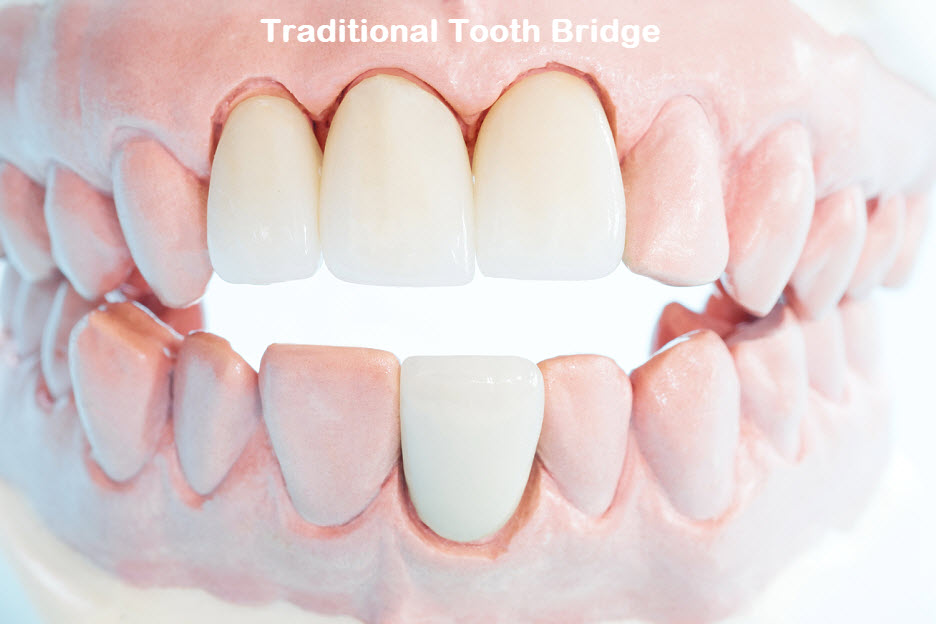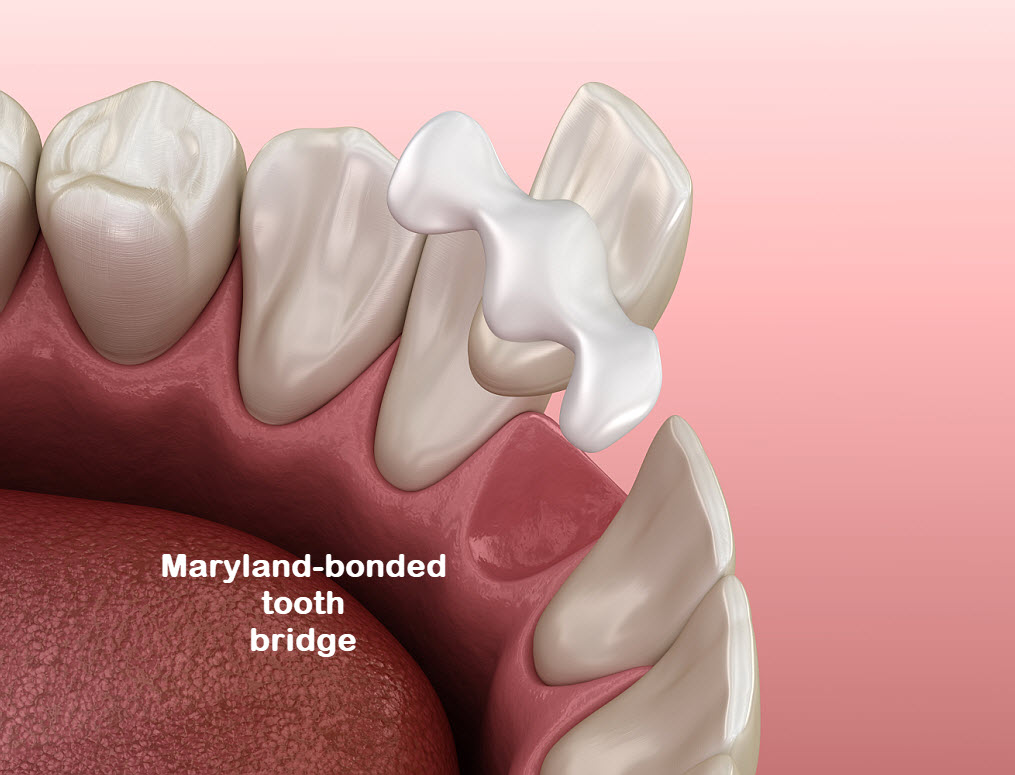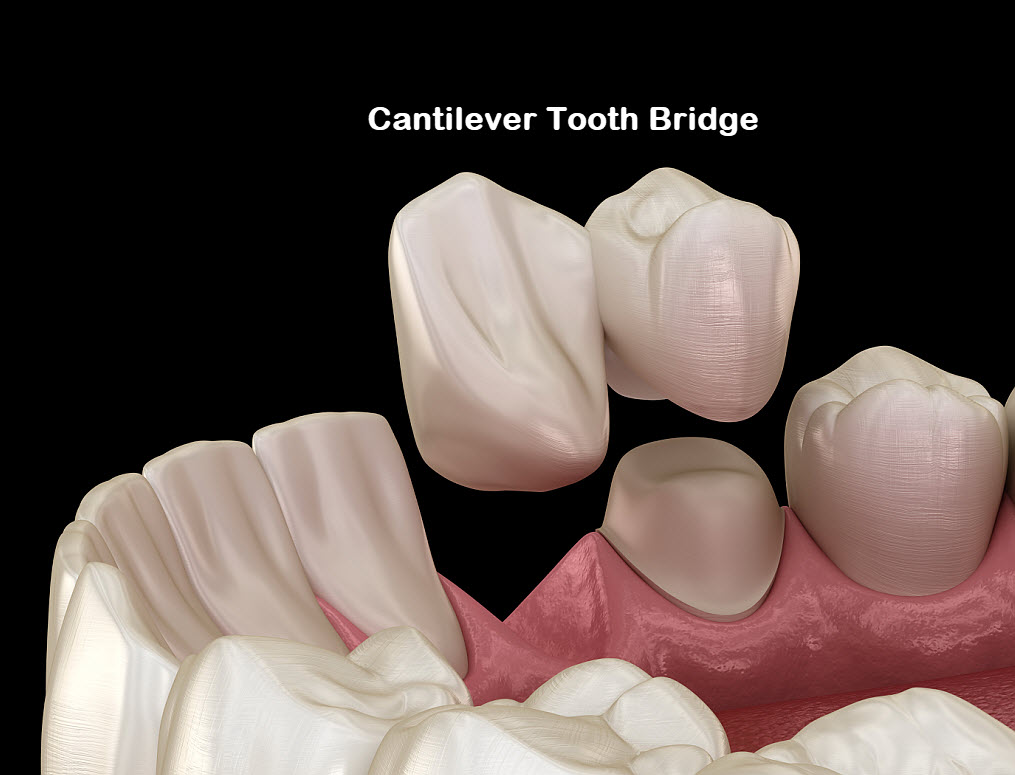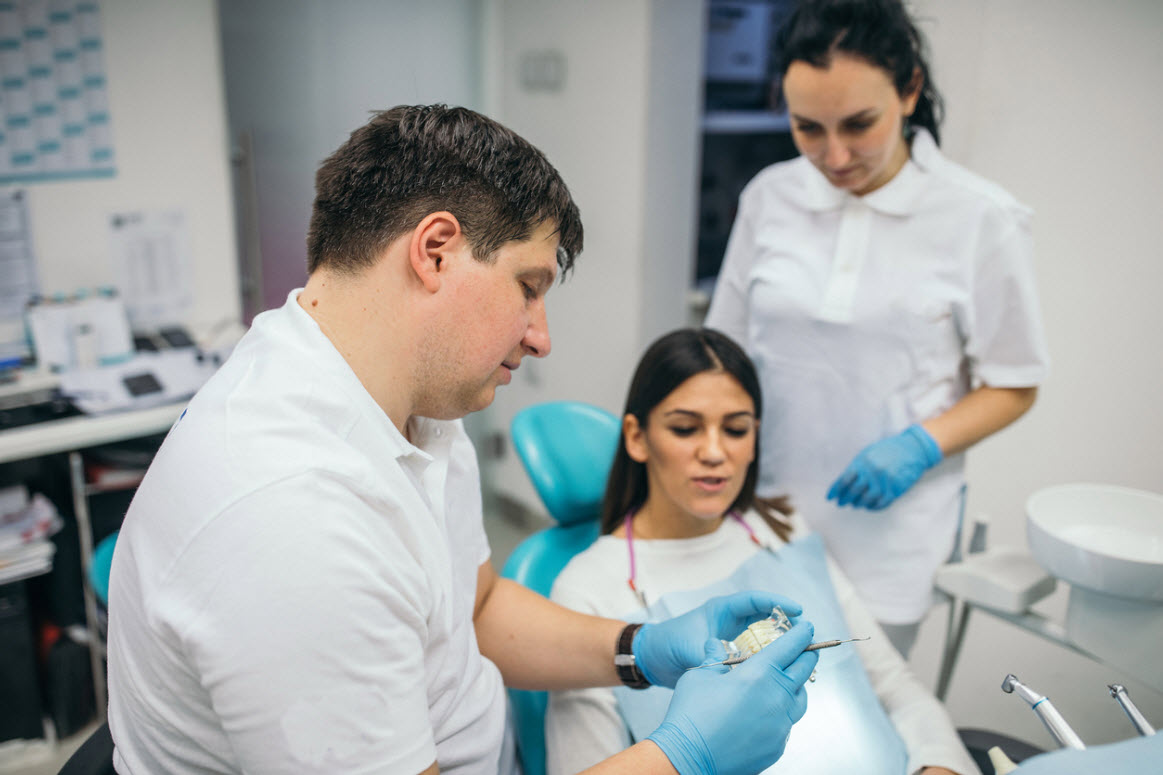Dental Bridge Brisbane

Dentists use a dental bridge to approximate a large gap in the oral cavity caused by missing teeth. It is a prosthesis that replaces one or more teeth. Your dental bridge will be supported by neighbouring teeth with dental crowns.
A dental bridge is indicated where a tooth has to be extracted and replaced. It is called a bridge because it is like a bridge over a river and like a river bridge, a dental bridge is is supported by an actual tooth called an abutment.
A traditional dental bridge is typically used when the missing teeth are in or near the back of the mouth. Let’s face it; missing teeth affect appearance. Missing teeth is one of the most devastating experiences as an adult. It may take a toll on your confidence, interfere with your day-to-day diet, cause irregular teeth wear, or cause adjacent teeth to drift or tilt into the unoccupied spaces. In addition, teeth in the opposite jaw may also shift upward or downward into the gap. And the consequence? This creates an irregular movement, affecting how your teeth bite, which can cause them to break, wear down, or become chipped.
Good news; it doesn’t have to reach that far, as you can seek help from a qualified dentist to help you bridge the gap created by one or more missing teeth. That’s right; a dental bridge is an excellent solution that can help restore the original look and function of the teeth risk-free.
Frequently Asked Questions
What are the advantages of dental bridges?
Dental bridges are a simple option for the replacement of a missing tooth. No surgical procedure is required for dental bridges, and the entire dental crown procedure can be completed within two weeks.
What are the disadvantages of dental bridges?
With a dental bridge, neighbouring teeth should be shaped so they can support the bridge. Maintaining the hygiene of dental bridges is a bit challenging. A dental implant is more permanent, and the cost of a single implant is close to the price of a dental bridge.
Can you put a bridge on your front teeth?
A few different options are available for replacing a missing tooth at the front of the mouth because the bite pressure on the front teeth is less than the back teeth. Common dental bridges for the front of the teeth include:
- Traditional bridges
- Maryland bonded bridges
- Cantilever bridges
How long after extraction can I get a dental bridge?
Typically it would be best to wait five to six months after tooth extraction for the gum shape to settle before having a dental bridge. Your dentist can make a temporary bridge or partial denture during this healing period as an interim measure.
Do dental bridges look natural?
Dental technology has come a long way in recent years. With modern dentistry, a dental bridge can be made to look like your natural teeth in shape, size and colour.
How often should a dental bridge be replaced?
An existing dental bridge may need to be replaced every five (5) to 15 years. They can last depending on proper care and maintenance. Dental implants are considered more permanent solutions compared to dental bridges. Dental hygiene and regular dental check-up and clean can increase the life of your dental bridges.
Are dental bridges bad for teeth?
The adjacent teeth on either side of a dental bridge will have to be shaped and capped with the crowns of the dental bridge. The placement of dental bridges results in losing some healthy tooth enamel. The trimming of the healthy teeth increases the risk of permanent damage to those teeth. Maryland bridges are not sturdy and can cause damage to the existing teeth.
What is a Dental Bridge?
Missing teeth can be replaced with dental implants, dentures or bridges. A dental bridge is a false tooth (better known as a pontic) that replaces one or more missing teeth in your mouth. They’re usually mounted on the gap and held by abutment teeth, i.e., the teeth supporting the dental bridge on each side. Plus, they mimic everything in a natural tooth, including the look, function, and shape.
Dental bridges can be made from various materials, including gold, porcelain, metal-ceramic, silver, etc. But the most commonly used material is porcelain, and it’s usually attached to metal for support. That’s because porcelain blends seamlessly with the aesthetics of natural teeth.
What are the Types of Dental Bridges Available?
There are four primary types of dental bridges:
- Traditional
- Maryland-bonded
- Cantilever
- Implant-supported
Traditional Dental Bridge
A traditional dental bridge is one of the fastest ways to replace a missing tooth. A traditional bridge consists of a pontic suspended between two crowns like a river bridge. Your dentist places these dental crowns over the teeth that are adjacent to the gap in your teeth.

The traditional dental bridge is the most common of the four types. Traditional bridges consist of two dental crowns on both ends of the bridge and prosthetic teeth or pontic between the crowns. The pontic is a fake tooth held in place by dental crowns that have been cemented into either side of the abutment teeth. These bridges primarily consist of porcelain fused to ceramic-metal or all-metal materials like gold and silver.
During the traditional dental “bridging” procedure, your dentist will shape and file the abutment teeth by removing some amount of enamel from them, ensuring that the dental crown fits seamlessly. Please note, however, that traditional dental bridges are only preferable if you have natural teeth on both sides of the space resulting from your missing tooth. If you have too many missing teeth, you may want to consider going for dentures instead.
Last but not least, traditional dental bridges work perfectly with posterior/back teeth like molars and premolars. And they’re strong and may stand the test of time, more so if well taken care of with regular checks up and hygiene.
Maryland-Bonded Dental Bridge

Like a traditional bridge, Maryland dental bridge requires natural abutment teeth, one on each side of the gap, to hold a pontic supported by a metal framework. Perhaps the only difference is that Maryland bridges are less invasive than the traditional ones.
Also, Maryland bridges use porcelain or metal frameworks/wings instead of dental crowns. And they (the frameworks/wings) are usually bonded to the backs of the adjacent abutment teeth to stabilise the bridge. Today, though, most Maryland bridges are bonded using porcelain wings instead of metal wings. That’s because the former mimics the colour of natural teeth.
Maryland bridges require less enamel removal, if at all, because the bridges usually attach to the backside of the abutment teeth adjacent to the missing tooth. Finally, the bridges are particularly excellent for restoring the front teeth (incisors). Unfortunately, they’re rarely effective on other teeth, especially not canines, as they’re vital to biting, which can cause the bridges to shift quickly.
Cantilever Dental Bridge

Cantilever dental bridges are also similar to traditional bridges, as they’re made of metal-fused porcelain. The only twist is that the pontic, usually held by a dental crown, can only be supported by one abutment tooth. Therefore, if you’re considering going for a cantilever dental bridge, ensure you have one natural tooth next to the gap created by the missing tooth.
Since the dental bridge is only supported on one side, the dental crown needs to fit perfectly. Hence, your dentist may have to shape your abutment tooth by removing some of its enamel. Finally, cantilever bridges are primarily used to restore the front teeth since they aren’t strong enough to endure the biting pressure of the back teeth.
Implant-Supported Dental Bridge
As the title suggests, this is a type of bridge that’s 100% supported on dental implants. That is, it doesn’t use dental crowns or metal frameworks to bridge the missing teeth gap. Essentially, a dental professional surgically places one implant for every missing tooth. Alternatively, the missing tooth/teeth may be replaced by a pontic suspended between two implant-supported dental crowns.
Either way, the placement process requires two surgeries:
- One for embedding the implants onto the jawbone
- And the second surgery for placing the bridge
Typically, implant-supported bridges are excellent for restoring the back teeth (molars and premolars). And it’s recommended if you have at least three back teeth missing in a row.
Who Needs Dental Bridges?

Did you know that Australian adults have an average of 4.5 missing teeth? That means virtually anyone of age can benefit from dental bridges. Anyway, you should consider going for dental bridges if:
- You’ve suffered an injury, gum disease, or tooth decay, causing you to lose teeth.
- You were born missing some teeth, thanks to a little-known congenital condition.
- You want to restore your glowing smile.
- You want to restore your ability to chew food properly.
- You want to prevent your remaining teeth from shifting out of position.
- You want to readjust your bite correctly for equal distribution of force when chewing.
- You want to restore your speech and pronunciation
Procedure for a Dental Bridge
Here’s a breakdown of what happens during the dental bridge procedure:
Step 1: Abutment Tooth Preparation and Temporary Bridge
Your first appointment is all about preparing you for the actual dental bridge placement procedure. After administering an anaesthetic to “kill the pain,” the dentist shapes and files the abutment tooth, ensuring that it blends seamlessly with the dental crown.
After that, the dentist makes impressions and proceeds to the dental lab to create a custom dental bridge. Meanwhile, the dental professional places a temporary bridge over the newly shaped teeth and the missing tooth gap. The idea is to test the abutment teeth’ strength, i.e., are they strong enough to support a permanent bridge? If not, the dentist takes a different cause of action to place dental implants into your jawbone (implant-supported bridge).
Step 2: Permanent Bridge Placement
The permanent bridge shall have been ready by the second visit, and you’ll need to return to the clinic for placement. But not so fast; the dentist will need to remove the temporary bridge and clean your teeth first. And if you feel any pain or sensitivity issues, you’ll have a local anaesthetic before the temporary bridge removal.
The final stage is placing the permanent bridge and conducting thorough checks (taking dental x-rays of the bridge) to confirm that it fits superbly. The dentist then bonds the bridge and the abutment teeth together using special dental cement, and you’re good to go!
How Should You Care for Your Dental Bridge?
Taking care of your dental bridges is a must if you want them to last long and prevent diseases like tooth decay. That means maintaining oral hygiene, eating healthy diets, going for regular professional cleanups, among other best practices.
Maintaining Oral Hygiene
You want to brush at least twice a day, rinse with mouthwash regularly, and floss underneath and between the bridge often. This helps reduce inflammation and prevents cavities or plaque buildup around the dental bridge. Please note that for effective flossing, you’ll need special tools like floss threaders, water floss, and super floss. It’s also critical that you consult your dentist for the right way to floss and brush.
Eating Healthy Diets
You should avoid specific foods (at least during the transition period) and others that you should eat more after a dental bridge placement. For instance, you should avoid icy foods like ice cream, sticky foods like candy, hard foods like nuts, etc. According to Brisbane Kids Dentist, you should make a habit of eating more vegetables, fruits, and fibre-rich foods.
Regular Professional Cleanups
Prevention is better than cure, or so they say. Seeing your dentist regularly for check-up and cleans can help detect flaws early, paving the way for a more successful treatment. Plus, regular professional cleanings help keep away dental problems in the first place.
While there’s no denying that missing teeth can affect the way you interact with people, eat, talk, or smile, it’s not a permanent disability. Anyone with missing teeth can have them replaced in a simple dental procedure, restoring your mouth’s original look and function. But, remember, even after the replacement, you should maintain good oral hygiene, eat healthily, and visit your dentist regularly for cleanings if you want the dental bridges to last beyond expectation.
At Pure Dentistry, we’re a team of highly trained and experienced dentists based in Brisbane. We leverage the latest technology, high-quality materials, and best-in-class expertise to help our patients overcome their dental issues. So get in touch with us today, and let us help restore your glowing smile with our dental bridge solutions!




































